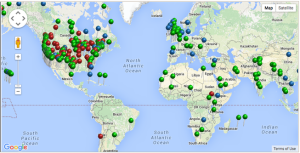Source: mnn.com
Published: October 7, 2015

This interactive map shows where plastic bags have been banned (green pins), where there is now a fee for them (blue pins), and where bans have been attempted but failed (red pins). Sadly, most of the red pins are in the United States. (Photo: Factory Direct Promos)
It’s hard to disagree that plastic bags are an environmental nuisance. Sure, they’re convenient and can be reused once or twice. Eventually, though, most of them end up in the landfill, stuck on a tree branch, or devastatingly find their resting place in the belly of sea life.
In 2015, England joined countries like Scotland and Italy in placing restrictions on plastic bags. The country enacted a 5-pence fee for plastic bags used in stores that have more than 250 employees. (That’s about 8 cents in U.S. money.) Shoppers have to pay for bags if they want to use them to haul home groceries and other goods.
“The number of plastic bags given out by seven major supermarkets in England rose by 200 million in 2014 to exceed 7.6 billion — the equivalent of 140 per person and amounting to 61,000 tonnes in total,” according to BBC News.
The new plastic bag fee has led to an 85 percent decrease in the number of plastic bags being used, according to BusinessWaste.co.uk, a national waste collection service in England.
It seems shoppers in England reacted the way shoppers in other countries have:
- In Ireland, a plastic bag tax was enacted in 2002. Plastic bag usage fell 90 percent.
- The 1993 Danish bag tax caused a decrease in usage. Now, Danes use around four bags per person annually.
Where does the money raised from the English bag fee go? Stores give some of it to the Treasury as a VAT (Value Added Tax), but they are allowed to keep a portion. Most stores, however, have said they will donate that money to charities instead of keeping it as profit, according to the Independent.
